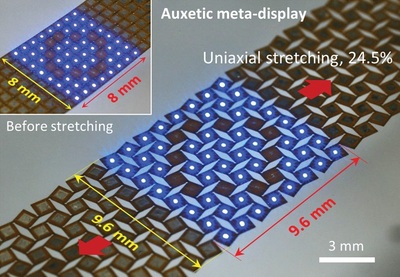Distortion-free, stretchable micro-LED displays developed

Researchers at the Korea Institute of Machinery and Materials (KIMM), an institute under the jurisdiction of the Ministry of Science and ICT, have successfully developed a 3″ meta-display that can be stretched up to 25% without image distortion — claimed to be a world first. Their breakthrough has been published in the journal Advanced Functional Materials.
The Department of Nano-Mechanics at KIMM has been researching the field of micro-LED transfer technology since 2008, but this is the first time the institute has developed a micro-LED meta-display that does not distort the displayed image, even when the display is pulled in a given direction. This was achieved by combining mechanical metamaterial designs and manufacturing technology with unique mechanical properties that do not exist in nature. This is because most stretchable materials in nature, such as rubber, demonstrate shrinkage in width when stretched lengthwise, thus resulting in image distortion; this was also the case for rubber-based stretchable displays.
The KIMM research team applied mechanical metamaterials with a negative Poisson’s ratio to a circuit board, Poisson’s ratio referring to the ratio at which the width of material shrinks when it is stretched lengthwise. When a mechanical metamaterial with a Poisson’s ratio of -1 is stretched lengthwise, it demonstrates the effect of stretching at the same ratio widthwise. Thus, a display using such materials is characterised by images that are not distorted. The method was applied to a leading large-area micro-LED roll transfer technology.

Senior researcher Dr Bongkyun Jang said his team had solved the fundamental issue of image distortion in stretchable displays by using meta-structures, and that they will continue to pursue the commercialisation of meta-display technologies so that they can be applied to various electronic products in the future. In addition to contributing to the diversification of platforms for mobile electronic devices, such as mobile phones and tablets, such displays can adhere to the skin of the human body without any wrinkles, thus allowing possibilities for application in the field of medical devices, beauty and health care.
Based on the successful results of their project, the research team plans to conduct follow-up research on micro-LED displays for ultra-realistic metaverses. Furthermore, in order to respond to the growing mini-LED and graphene industries, the team has established a spin-off company, YTS Micro-Tech and MCK-Tech, to promote the practical use of these new technologies.
Please follow us and share on Twitter and Facebook. You can also subscribe for FREE to our weekly newsletter and bimonthly magazine.
Organic transistor 'limitation' improves stability
Researchers have shown that a longstanding organic transistor design limitation actually improves...
OLED circular polarisation is now electrically switchable
Researchers have discovered a way to control left- or right-handed polarised light via charge...
Nanoscale pixels to advance augmented reality eyewear
Physicists have developed extremely small pixels that can be used in compact AR glasses, using...





